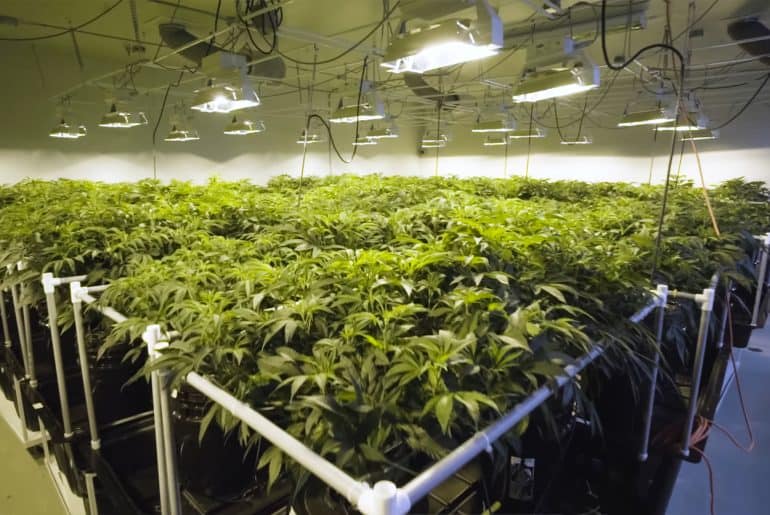You probably know that most beginners who start growing their own cannabis usually start with soil as the growing medium. Most people just put their seeds in some soil, put them under light, give them water, and that’s about it. However, growing your cannabis in a soil medium is not the only option you have at the spousal.
Another great way to grow cannabis is using the hydroponic method. Hydroponic growing of plants has been around for many hundreds if not thousands of years at this point.
However, it was not until recently that cannabis growers started using hydroponic systems to grow their own weed at home, and quite successfully we might add. Ever since hydroponic cannabis growing was discovered, it has become extremely popular, which is true for a variety of reasons, all of which we will discuss below.
Today, we are going to take you on an in-depth hydroponic cannabis growing guide to provide you with all the information that you need to know about it.
We will start with the history of hydroponics and what it actually is, move on to talk about the different types of hydroponic setups, and much more. By the end of this article, you will know quite literally everything there is to know about hydroponic cannabis growing.
What is Hydroponics Weed?
The hydroponic growing method is a soilless growing method of growing any plant, in this case cannabis, where water is used as the main growing medium.
In a hydroponic growing setup, the weed plants are grown in either baskets, buckets, or any other type of container that are filled with an inert growing medium, which we will discuss later today, which are then suspended over tanks of water.
If you are wondering where the nutrients come from to feed your plants, they are suspended in the water column, as opposed to a soil-based growing method where all of the nutrients are suspended in the soil. Not only is the water filled with many nutrients, but also air stones, which are designed to help aerate the tank.
This is a very basic model of a hydroponic cannabis growing system, and there are actually many different types, which both passive and active hydroponic cannabis growing systems.
You might think that hydroponic growing is a very modern advancement, but this really isn’t the case. Hydroponic systems have been around for hundreds if not thousands of years, with evidence being found at the hanging gardens of Babylon that were created in roughly 600 BCE. It is theorized that a trickle system was it used to aerate crops in this extremely arid area of the world.
We then have the Aztecs, mainly during the 10th and 11th centuries, which were also known to use hydroponic systems to grow crops to feed their societies. It is also theorized that after a specific land conflict, when many of the Aztecs were moved to lake Tenochtitlan, that they built floating rafts that were topped with soil, which would allow crops to grow through the soil and down into the water.
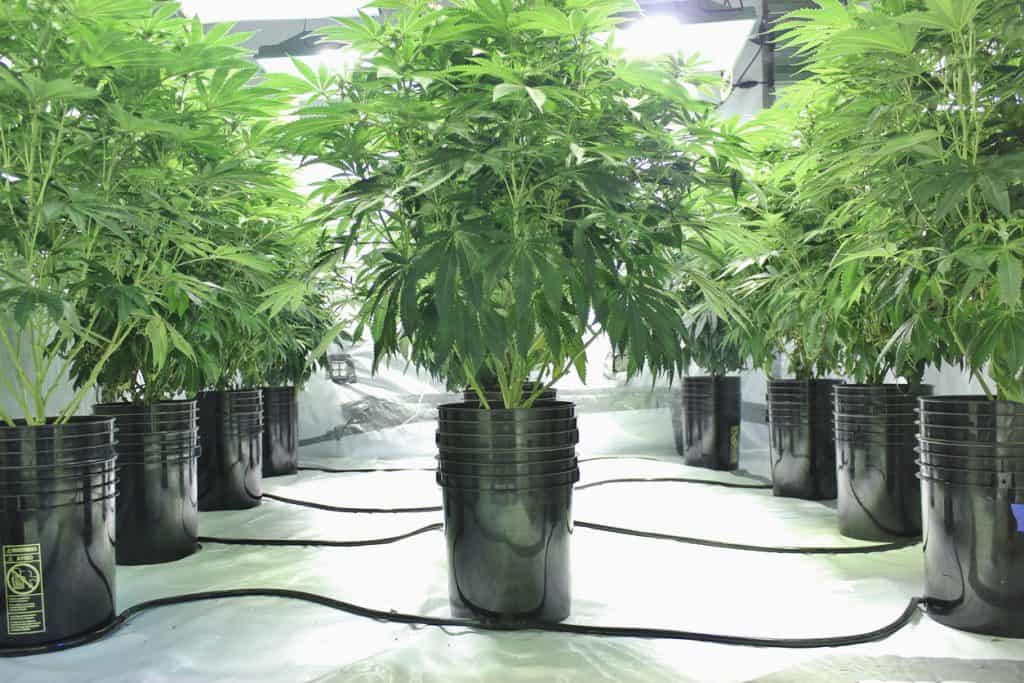
Different Types of Hydroponic Growing – Passive vs Active Setups
Many people think that growing cannabis hydroponically involves just placing the plants in water, but this really isn’t true. First and foremost, there are two main types of hydroponics systems that are used for growing cannabis and many other types of crops.
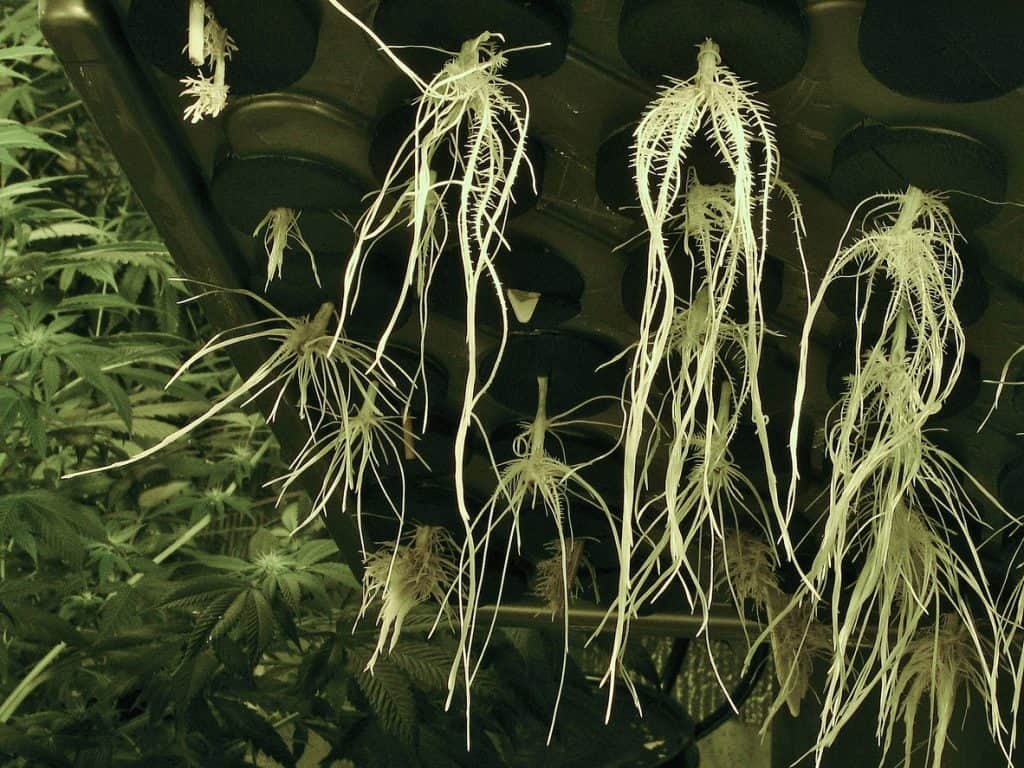
Passive Hydroponics Systems
The first is the passive hydroponic system for cannabis, which uses very low technology delivery methods to provide nutrients and water to the roots of the cannabis plant, all without any additional electricity being used. Many people prefer passive hydroponics systems for a variety of reasons, especially where beginners are concerned.
The main reason is because it’s just a very low-tech alternative, which means that you don’t have to purchase many items, and therefore making it fairly inexpensive and easy to set up. It also doesn’t use any electricity, so you don’t have to worry about your power bill too much. It’s just a really great method for beginners.
You must however be careful, because there are some types of passive hydroponics systems that may still require you to provide the plants with small amounts of additional water, especially where systems such as the wick system are concerned, which we will take a closer look at below.
Active Hydroponics Systems
We then have active hydroponics system for growing cannabis which take advantage of many modern technologies to keep plants aerated, water, and fed. The active hydroponics system generally includes air pumps, air stones, pumps, and other pieces of technology to provide the plants with the required nutrients and water that they need to survive.
What is really beneficial about this type of hydroponic cannabis system is that it is very easy to automate, therefore providing your plants with water, light, and everything else, all with a schedule, which means that it makes life a lot easier for the grower.
Something else that stands out about this type of hydroponic setup is that they tend to produce much better results, especially because they tend to provide plants with more oxygen and water than passive systems do.
There are several main types of active hydroponics systems that are worth looking into, including deep water culture, the nutrient film technique, drip system, ebb and flow, and others.
Examples of Popular Types of Hydroponics Systems
Seeing as there are several types of both active hydroponic systems and passive hydroponics systems, we want to take a quick look at all of them right now.
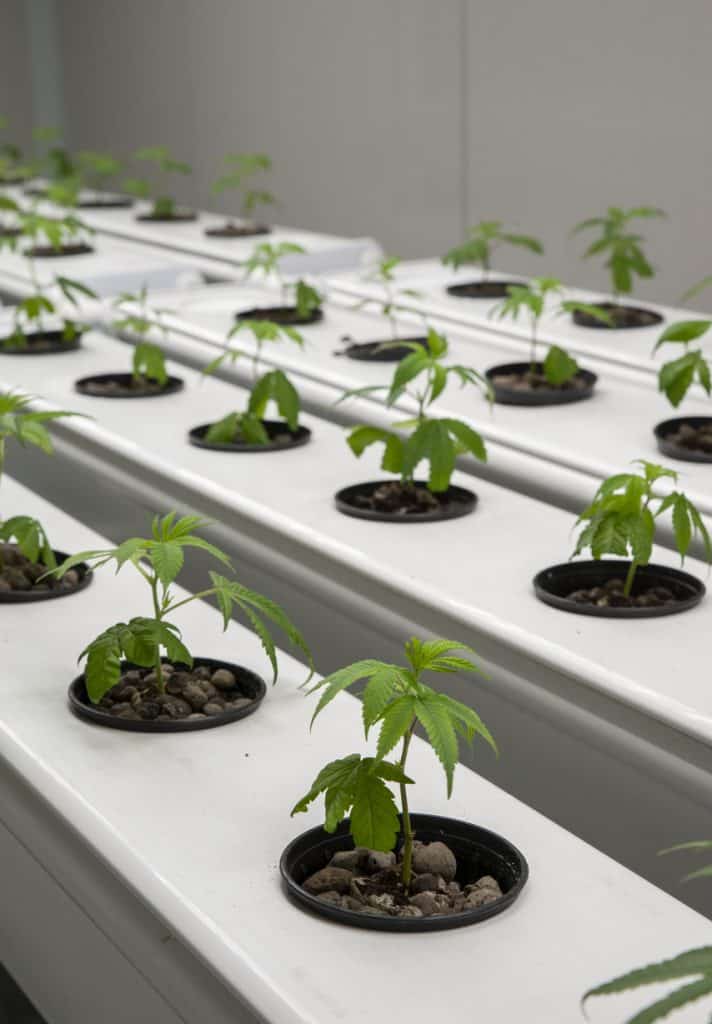
The Kratky Method
First, we have a basic passive hydroponic setup, known as the Kratky hydroponics method. It was developed by Dr. Bernard Kratky, a horticulturalist. It’s often used for growing leafy greens without the use of pumps, electricity, or any complex nutrient delivery systems.
This is a non-circulating hydroponic setup, which means that the nutrients are not pumped or circulated around the roots of the plant, but instead relies on a static solution that provides the plants with nutrients required to grow. The main principle behind this method is that the nutrient solution level decreases more plants absorb the nutrients, therefore creating an air gap between the roots and the nutrient solution.
The Kratky method is often preferred by many because it is very low cost, simple, easy to set up, and great for beginners who just want to grow a few plants. That said, it’s not the best option to use for plants that have very high nutrient and water requirements, and it’s not ideal for plants that have very long growth cycles either.
The Wick System
We then have the wick hydroponics system, which is also known as the passive wick hydroponics system, and this is another one of the simplest ways to grow hydroponic cannabis you can go with. This particular hydroponics system uses capillary action, which means that the material is used to function as a wick, which draws the nutrient solution from a reservoir beneath the plants into the plants root zone.
This is a very easy to set up system that is ideal for growing small and medium sized plants that don’t have massive nutrient requirements. Here, you will need two containers, one for a nutrient solution reservoir and the other for the plants, with the plant container generally being filled with an inert growing medium.
You’ll then also need a wicking material, such as nylon, felt, cotton rope, or any other such absorbent material. One end will be placed in the nutrient reservoir, where best the other will be placed in the growing medium in the plant container. The main advantage of this type of hydroponics system is that it does not cost much, not to mention that it is also very simple and easy to maintain.
There aren’t any electrical components or moving parts, so it’s very easy for beginners to set up. A big drawback with this type of hydroponic system however is that it is not ideal for very big plants that have huge nutrient requirements, because this type of watering method may not supply your plants with enough water and nutrients for their growth, which means that you may need to supplement with your own watering schedule.
Deep Water Culture
Now we have active hydroponic systems, with one of the most popular ones being deep water culture. This is a specific type of hydroponic system that involves suspending all of the plant roots in a oxygenated and nutrient rich water solution. This is a very popular method for growing many different types of plants, especially herbs, leafy greens, and cannabis.
This may also be referred to actually floating raft or the raft system. Here, you will see a large and shallow container or tank that is made out of plastic, which holds the nutrient solution. Inside of that tank, a buoyant material is used to create a floating raft, which is often polystyrene foam, which is then placed on the nutrient solution. The floating raft supports cups and pots, which hold the cuttings and seedlings.
There are then air pumps and air stones, along with diffusers, which are used to aerate and oxygenate the water, so that the plant roots get oxygen. The roots of the plants then grow down through the cups into the water and nutrient solution below.
This is a great type of hydroponics system to use because although it is an active system, it is still quite simple and effective, plus it is suitable for many different types of plants. It is also ideal because this method supplies your plant roots with a constant supply of all three, therefore resulting in fast growth and higher yields.
One of the big drawbacks of this method however is that it can be challenging to manage when you have big plants that have large root systems, because room on the floating raft can become very limited. Furthermore, if you have any equipment failures or power outages, this can also spell disaster for your crop.
Ebb and Flow
The next type of active hydroponics system is the ebb and flow hydroponics method, which may also be known as flood and drain. This is a very versatile and popular hydroponic system that is often used for growing a wide range of plants, such as herbs, flowers, vegetables, and cannabis.
This method is characterized by the intermittent flooding of the plant roots with a strong nutrient solution, which is then allowed to drain away, therefore providing your plants with a good cycle of aeration and hydration.
Here, you will see a grow bed or tray where the plants are put into, which is filled with a growing medium, which could be perlite, coconut coir, or anything else of this sort. A nutrient solution is stored in a reservoir which is located directly below the grow bed, and using a submersible pump is pumped into the grow bed from the reservoir, which floods it for a certain period of time.
After the flood happens, the pump is subsequently turned off, with the nutrient solution draining back out into the reservoir, with excess nutrient solution being collected back in the reservoir thanks to the drainage system. This is a great option you consider because the intermittent flooding and draining helps to provide the routes with oxygen and nutrients, which creates a very oxygen rich environment.
This system is also ideal because it provides you with a very efficient use of nutrients and provides the root zone with plenty of oxygen. Furthermore, this periodic draining and flooding also helps to prevent the buildup of toxins in the root system.
What many people also like is that this is a very easy to customize and scalable system, which means that both small scale and large scale grow operations can be created with it.
That said, one of the drawbacks of the ebb and flow system is that it requires a lot of complex and expensive grow equipment and monitoring equipment compared to some of the other methods talked about today, you’ll definitely need a timing system, a submersible pump, and various other pieces of technology.
Drip System
We then have the drip system, otherwise known as the drip irrigation system, which is one of the most popular methods of hydroponic cultivation, both for cannabis and other plant types alike. Here, you will see a controlled amount of a nutrient solution being delivered directly to the roots of the plants in a drip by drip manner, almost like when a patient is hooked up to an IV in a hospital.
Here, you will see plants being grown in containers or trays that are filled with a growing medium, which we will discuss below.
Each plant has an individual container, which will be connected to the central nutrient solution reservoir. You will then also need drip steaks or drip emitters installed above each plant, which are connected through tubing to the nutrient solution, which carries that nutrient solution from the reservoir to the plants.
There are also some cases where the nutrient solution is recirculated. A big advantage to the drip system is that it is very versatile, plus it is very easy to automate. Furthermore, this system also allows for a very efficient use of both nutrients and water, as each plant can receive an individualized and customized supply of nutrients, which therefore allows for great PH control in the root zone. Furthermore, this system is also very easy to scale for larger operations.
That said, one of the biggest drawbacks of the drip hydroponics system is that the drip emitters can easily clog, which can spell disaster for your crop. Therefore, it is very important to use high quality materials and items for this system. This system also requires very diligent and constant monitoring of the pH levels and the nutrient solution.
Nutrient Film Technique
Finally, we then have the nutrient film technique, which is a specific type of hydroponic system that involves a continuous flow of a thin film of very nutrient-rich water over the roots of the plants. This allows the roots of the plants to absorb nutrients and water while also getting oxygen.
This is a very suitable method for small and medium sized plants that don’t have extensive root systems. Here, you will see gutters or sloped channels that are usually made out of plastic, which are mounted at a slight angle which allows the nutrient solution to flow down through them thanks to gravity.
Plants are then placed in small cups or pots, with the roots dangling down into those sloped channels so that the nutrient film can run over them. There is then also generally a recirculating system at the bottom which pumps the nutrient solution to the top of the channels, therefore providing you with an effective and efficient use of nutrients and water.
This is a great technique to use because it allows for a very efficient use of both nutrients and water. Furthermore, it is very suitable for fast growing plants, and it is easy to scale for larger grow operations. The system provides plants with a constant supply of water and nutrients, as well as oxygen, which helps to support their healthy development and growth.
There are however some drawbacks to the nutrient film technique, with the flow rate of the nutrient solution being one of them, because it roots of plants can become their waterlogged or dried out if the flow rate is not adjusted properly. Any errors committed with this growing method may spell disaster for your plants very quickly.
Growing Mediums for Hydroponics
One important thing to cover are the different growing mediums that you might use for a hydroponics setup. This medium is designed primarily to hold in place the intersection of the roots and stems, as this is where the roots will grow down into the water to get nutrients.
The inert medium also provides great air access to the top of the roots. There are many different types of growing mediums used for hydroponics, with regular clay pebbles being one of the best ones.
Many people also choose to use rockwool, which is great because it allows for great hydration of the upper root system because it has a great capacity to retain water.
Many people also choose to use perlite, which is a specific type of volcanic glass that is sensitive to higher temperatures, and will expand when it gets warm. It’s a great option to use in hydroponics systems because it allows for great aeration.
Coco coir is another popular option to consider, as it is very sustainable and able to protect delicate plant roots.
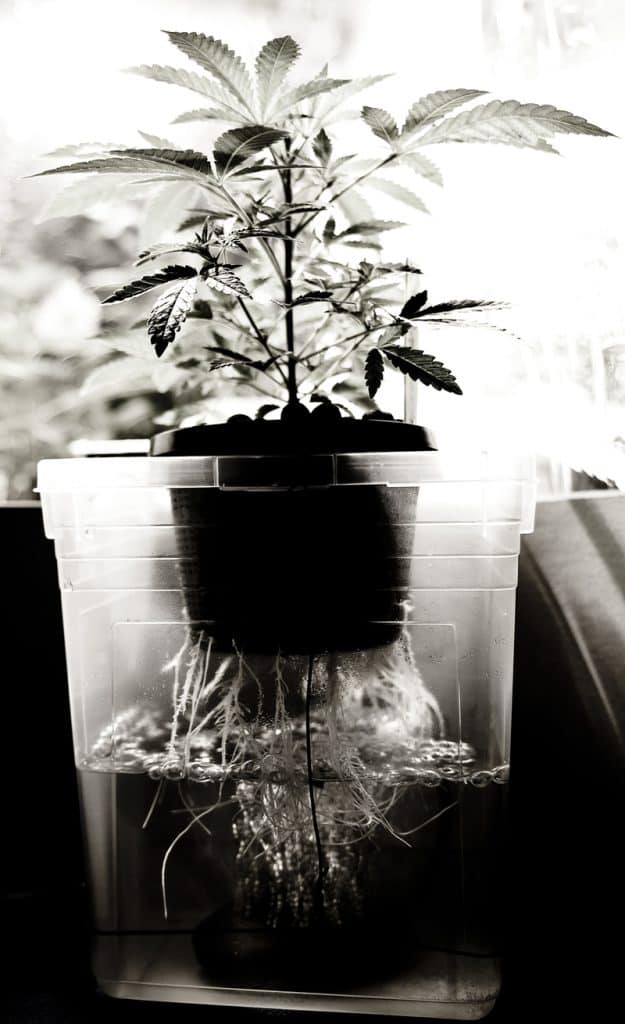
Pros and Cons of Growing Weed Hydroponically
Now that you know what all of the different types of hydroponics growing systems are, let’s take a quick look at some of the biggest advantages and disadvantages of this type of growing method.
Pros
- One of the biggest advantages of using a hydroponics growing system for cannabis is that due to the controlled environment that is optimized for cannabis plants, it often results in faster growth rates, bigger plants, and overall higher yields.
- Many people also prefer the hydroponic growing method because it allows for very precise nutrient control. Here, you have great control over nutrient levels, pH levels, and all of the other factors that decide your plant’s health.
- What also stands out to many people is that hydroponics systems are very efficient with water, especially when compared to soil-based methods. This is because they usually recycle the nutrient solutions, which reduces the amount of water wasted.
- Another factor that stands out with hydroponics growing methods is that they can be optimized for vertical growing, which means that they can be very Spacey efficient.
- Hydroponics systems are also great at reducing the risk of pests and soil borne diseases from occurring, which often leads to much healthier plants.
- The other big advantage of using hydroponics as the main growing method is that it allows you to grow weed plants 365 days of the year regardless of weather.
Cons
- One of the biggest drawbacks of using hydroponic system, especially an active one, is that the initial investment will be quite high. There are notable costs associated with the equipment and more.
- You also need to be aware that a hydroponic growing system requires a lot of monitoring and maintenance to ensure that it is functioning properly, that system cannot fail, and to ensure that nutrients are properly balanced.
- This is a fairly complex growing method that involves a big learning curve. You need to understand nutrient management, environmental controls, and the mechanics of the specific system you are using. On that note, here you are also risking nutrient toxicities, deficiencies, or imbalances, because hydroponics systems don’t have much room for error.
- But also stands out about a hydroponic growing method is that it is susceptible to power outages. If you have an active system and the power goes out, you’re going to run into some big problems.
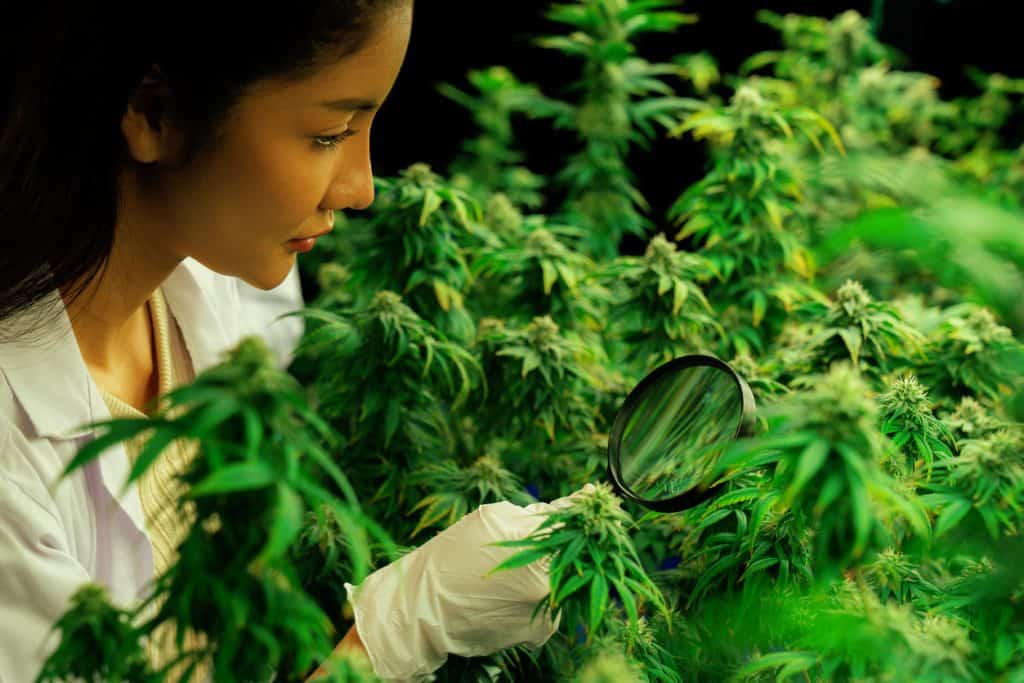
Conclusion
As you can see, hydroponic growing systems can be extremely beneficial, especially when it comes to increasing the overall size and yield of your plans. It allows you to provide the plants with specific nutrient solutions at the ideal levels.
This level of control is what many people prefer about hydroponics systems. Just remember that there is a bit of an initial investment involved, as well as a learning curve, but once you master hydroponic cannabis growing, you might just never go back to using soil.

